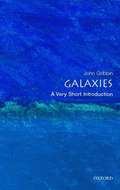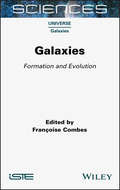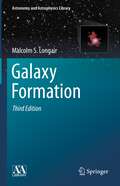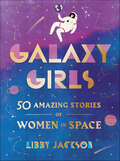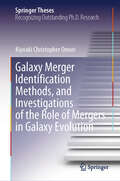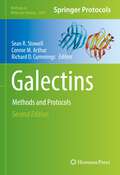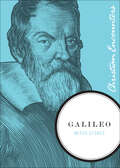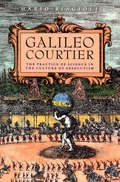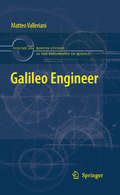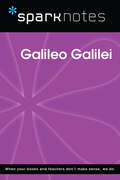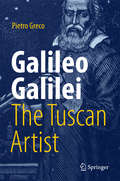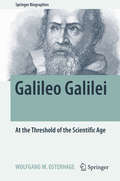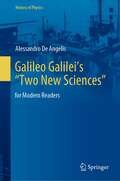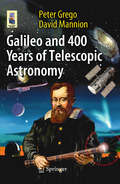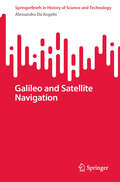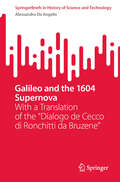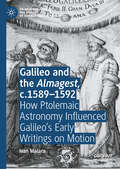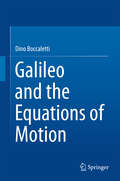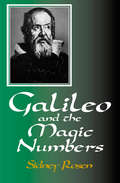- Table View
- List View
Galaxies in the Universe: An Introduction
by Linda S. Sparke John S. Gallagher IIIGalaxies are the places where gas turns into luminous stars, powered by nuclear reactions that also produce most of the chemical elements. But the gas and stars are only the tip of an iceberg: a galaxy consists mostly of dark matter, which we know only by the pull of its gravity. The ages, chemical composition and motions of the stars we see today, and the shapes that they make up, tell us about each galaxy's past life. This book presents the astrophysics of galaxies since their beginnings in the early Universe. This second Edition is extensively illustrated with the most recent observational data. It includes new sections on galaxy clusters, gamma ray bursts and supermassive black holes. Chapters on the large-scale structure and early galaxies have been thoroughly revised to take into account recent discoveries such as dark energy. The authors begin with the basic properties of stars and explore the Milky Way before working out towards nearby galaxies and the distant Universe, where galaxies can be seen in their early stages. They then discuss the structures of galaxies and how galaxies have developed, and relate this to the evolution of the Universe. The book also examines ways of observing galaxies across the electromagnetic spectrum, and explores dark matter through its gravitational pull on matter and light. This book is self-contained, including the necessary astronomical background, and homework problems with hints. It is ideal for advanced undergraduate students in astronomy and astrophysics. Book jacket.
Galaxies, Galaxies! (New & Updated Edition)
by Gail GibbonsPlanet Earth is in the Milky Way Galaxy, the cloudy band of light that stretches clear across the night sky. How many galaxies are there in the universe? For years astronomers thought that the Milky Way was the universe. Now we know that there are billions of them. Gail Gibbons takes the reader on a journey light-years away.
Galaxies, Galaxies! (Third Edition)
by Gail GibbonsLearn about the newest discoveries in the Milky Way and beyond in this updated edition from nonfiction master Gail Gibbons.Planet Earth is in the Milky Way Galaxy, the cloudy band of light that stretches clear across the night sky. How many galaxies are there in the universe? For years astronomers thought that the Milky Way was the universe. Now we know that there are billions of them. Gail Gibbons takes the reader on a journey light-years away.This updated edition vetted by an expert introduces young readers to our own galaxy the Milky Way and beyond. Learn how ancient people invented the telescope and began studying the Milky Way to the modern technology astronomers use to study other galaxies.Gail Gibbon&’s easy-to-read text and clearly labeled illustrations welcomes young readers to learn how telescopes work, about the different types of galaxies, how many galaxies we know of today, and more.
Galaxies: A Very Short Introduction
by John GribbinIn this fascinating Very Short Introduction, popular science writer John Gribben tells the story of our growing understanding of galaxies, from the days before Galileo to our present-day observations of our many hundreds of millions of galactic neighbors. Not only are galaxies fascinating astronomical structures in themselves, but their study has revealed much of what we know today about the cosmos, providing a window on the Big Bang and the origins of the Universe. Gribben looks at our own "Milky Way" Galaxy in detail, from the different kinds of stars that are born within it, to the origins of its magnificent spiral structure. Perhaps most interesting, Gribben describes the many exciting discoveries have been made about our own galaxy and about those beyond: how a supermassive black hole lurks at the center of every galaxy, how enormous forces are released when galaxies collide, how distant galaxies provide a window on the early Universe, and how the formation of young galaxies shed needed light on the mysteries of Cold Dark Matter.
Galaxies: Formation and Evolution
by Françoise CombesGalaxies are vast ensembles of stars, gas and dust, embedded in dark matter halos. They are the basic building blocks of the Universe, gathered in groups, clusters and super-clusters. They exist in many forms, either as spheroids or disks. Classifications, such as the Hubble sequence (based on mass concentration and gas fraction) and the colormagnitude diagram (which separates a blue cloud from a red sequence) help to understand their formation and evolution. Galaxies spend a large part of their lives in the blue cloud, forming stars as spiral or dwarf galaxies. Then, via a mechanism that is still unclear, they stop forming stars and quietly end in the red sequence, as spheroids. This transformation may be due to galaxy interactions, or because of the feedback of active nuclei, through the energy released by their central super-massive black holes. These mechanisms could explain the history of cosmic star formation, the rate of which was far greater in the first half of the Universe's life. Galaxies delves into all of these surrounding subjects in six chapters written by dedicated, specialist astronomers and researchers in the field, from their numerical simulations to their evolutions.
Galaxies: Inside the Universe's Star Cities
by David EicherHave you ever wanted to explore the Milky Way? Are you curious about how black holes form (and what really happens if you get stuck in one)?Do you want to learn how to read the night sky from your back garden?Tour the most dazzling, fascinating, and unusual galaxies in the universe with the editor in chief of Astronomy as your personal guide, featuring jaw-dropping illustrations and full-colour photography from the magazine's archives, much of it never before published. The cheapest one-way ticket to space money can buy, Galaxies will answer all of your questions about the mysteries of our cosmos.
Galaxies: Inside the Universe's Star Cities (Astronomy Library #Vol. 4)
by David J. EicherTour the incredible scope of the cosmos as we know it with the editor in chief of Astronomy, featuring jaw-dropping illustrations and full-color photography from the magazine&’s archives, much of it never before published. &“The natural history of the galaxies is majestic and deserves its own David Attenborough. In David Eicher, it may have just found him.&”—Richard Dawkins Journey to the edges of our galaxy and beyond with one of the most widely recognized astronomy experts as your guide. Delve into the history of stargazing and space observation, learn how black holes power galaxies, and understand the classification of the different galaxy types. This illuminating book—with artful illustrations and never-before-seen space photography—will open your mind to the wonders of the universe that await.
Galaxy Formation (Astronomy and Astrophysics Library)
by Malcolm S. LongairDelineating the huge strides taken in cosmology in the past ten years, this much-anticipated second edition of Malcolm Longair's highly appreciated textbook has been extensively and thoroughly updated. It tells the story of modern astrophysical cosmology from the perspective of one of its most important and fundamental problems – how did the galaxies come about? Longair uses this approach to introduce the whole of what may be called "classical cosmology". What’s more, he describes how the study of the origin of galaxies and larger-scale structures in the Universe has provided us with direct information about the physics of the very early Universe.
Galaxy Formation and Evolution
by Houjun Mo Frank Van Den Bosch Simon WhiteThe rapidly expanding field of galaxy formation lies at the interface between astronomy, particle physics, and cosmology. Covering diverse topics from these disciplines, all of which are needed to understand how galaxies form and evolve, this book is ideal for researchers entering the field. Individual chapters explore the evolution of the Universe as a whole and its particle and radiation content; linear and nonlinear growth of cosmic structure; processes affecting the gaseous and dark matter components of galaxies and their stellar populations; the formation of spiral and elliptical galaxies; central supermassive black holes and the activity associated with them; galaxy interactions; and the intergalactic medium. Emphasizing both observational and theoretical aspects, this book provides a coherent introduction for astronomers, cosmologists, and astroparticle physicists to the broad range of science underlying the formation and evolution of galaxies.
Galaxy Girls: 50 Amazing Stories of Women in Space
by Libby JacksonFilled with beautiful full-color illustrations, a groundbreaking compendium honoring the amazing true stories of fifty inspirational women who helped fuel some of the greatest achievements in space exploration from the nineteenth century to today—including Hidden Figure’s Mary Jackson and Katherine Johnson as well as former NASA Chief Astronaut Peggy Whitson, the record-holding American biochemistry researcher who has spent the most cumulative time in space.When Neil Armstrong stepped off the ladder of the lunar module, Eagle, he famously spoke of “one small step for man.” But Armstrong would not have reached the moon without the help of women. Today, females across the earth and above it—astronauts and mathematicians, engineers and physicists, test pilots and aerospace psychophysiologists—are pushing the boundaries of human knowledge, helping us to understand the universe and our place in it. Galaxy Girls celebrates more than four dozen extraordinary women from around the globe whose contributions have been fundamental to the story of humankind’s quest to reach the stars.From Ada Lovelace in the nineteenth century to the “colored computers” behind the Apollo missions, from the astronauts breaking records on the International Space Station to the scientific pioneers blazing the way to Mars, Galaxy Girls goes boldly where few books have gone before, celebrating this band of heroic sisters and their remarkable and often little known scientific achievements. Written by Libby Jackson, a leading British expert in human space flight, and illustrated with striking artwork from the students of London College of Communication, Galaxy Girls will fire the imaginations of trailblazers of all ages.
Galaxy Merger Identification Methods, and Investigations of the Role of Mergers in Galaxy Evolution (Springer Theses)
by Kiyoaki Christopher OmoriThis book offers new findings on the impact of galaxy mergers on galaxy evolution and related processes. Galaxies are astronomical objects composed of stars, gas, and dark matter. The main pathway for galaxy evolution in the currently accepted model for structure growth is through interactions and mergers, or the process in which multiple galaxies interact, collide, and end up as one larger galaxy. Galaxy interactions and mergers are also considered to drive various processes pertaining to galaxy evolution, such as star formation, active galactic nuclei (AGN) activity, and chemical evolution. As such, not only are merging galaxy systems important to understand galaxy structure growth in a cosmological context, they are also unique laboratories to study evolutionary processes taking place in galaxies. However, despite their importance, the relative role of galaxy mergers on galaxy evolution is still heavily contested. One reason for this is difficulty in identifying merger galaxies in observational data. Many different methods have been adopted for merger galaxy identification, but none of them are perfect. Moreover, the use of differing selection methods can result in widely different samples, which can alter statistical results. As such, a novel, robust method for merger identification is required to deepen our understanding of galaxy mergers. In this book, we introduce new methods to identify galaxy mergers from observational data. The first method combines the use of visual identification—both of optical and kinematic images—with spectroscopic pair identification. The second is machine learning based, using a training method called fine-tuning, an application of transfer learning. A pre-trained model on galaxy images is further fine-tuned using a sample of synthetic galaxy images, to make a classifier for merger identification. Using samples identified by our methods, the author conducts three studies: the impact of mergers on galaxy chemical evolution, the effect of galaxy local environment on merging activity, and the connection between mergers and AGN activity. This book is mainly intended for astrophysicists, particularly those studying galaxies, however is open for all to read.
Galectins: Methods and Protocols (Methods in Molecular Biology #2442)
by Sean R. Stowell Richard D. Cummings Connie M. ArthurThis second edition is dedicated to new and updated methodological approaches designed to study galectin function. Chapters examine salient features of galectin functions. Written in the successful Methods in Molecular Biology series format, chapters include introductions to their respective topics, lists of the necessary materials and reagents, step-by-step, readily reproducible protocols, and notes on troubleshooting and avoiding known pitfalls. Authoritative and cutting-edge, Galectins: Methods and Protocols, Second Eidtion aims to be a useful practical guide to researches to help further their study in this field.
Galileo (Christian Encounters)
by Mitch StokesWe learn about life through the lives of others. Their experiences, their trials, their adventures become our schools, our chapels, our playgrounds. Christian Encounters, a series of biographies from Thomas Nelson Publishers, highlights important lives from all ages and areas of the Church through prose as accessible and concise as it is personal and engaging. Some are familiar faces. Others are unexpected guests. Whether the person is Galileo, William F. Buckley, John Bunyan, or Isaac Newton, we are now living in the world that they created and understand both it and ourselves better in the light of their lives. Their relationships, struggles, prayers, and desires uniquely illuminate our shared experience.HERO OR HERETIC? GENIUS OR BLASPHEMER?It's no mystery how profound a role Galileo played in the Scientific Revolution. Less explored is the Italian innovator's sincere, guiding faith in God. In this exhaustively researched biography that reads like a page-turning novel, Mitch Stokes draws on his expertise in philosophy, logic, math, and science to attune modern ears with Galileo's controversial genius.Emerging from the same Florentine milieu that produced Dante, da Vinci, Machiavelli, Michelangelo, Amerigo Vespuci, Galileo questioned with a persistence that spurred his world toward an unabating era of discovery. Stokes confronts the myth that Galileo's stance on heliocentricity stood astride a church vs. science divide and explores his calculations for the dimensions of Dante's hell, his understanding of motion, and his invention of the pendulum clock.To read this volume is to journey through Galileo's remarkable life: from his inquisitive childhood to his dying days, when, although blind and decrepit, he soldiered on, dictating mathematical thoughts and mentoring young proteges.
Galileo Courtier: The Practice of Science in the Culture of Absolutism (Science and Its Conceptual Foundations series)
by Mario BiagioliInformed by currents in sociology, cultural anthropology, and literary theory, Galileo, Courtier is neither a biography nor a conventional history of science. In the court of the Medicis and the Vatican, Galileo fashioned both his career and his science to the demands of patronage and its complex systems of wealth, power, and prestige. Biagioli argues that Galileo's courtly role was integral to his science—the questions he chose to examine, his methods, even his conclusions.Galileo, Courtier is a fascinating cultural and social history of science highlighting the workings of power, patronage, and credibility in the development of science.
Galileo Engineer
by Matteo VallerianiThis work systematically investigates and reconstructs the practical knowledge Galileo shared during his lifetime. Galileo shared many aspects of practical knowledge. These included the methods and experience of foremen and engineers active within various frameworks. Galileo did not always react to such scientific impulses in the same way. On the one hand, he not only shared practical knowledge, but also acted as an engineer, especially within the framework of the art of war at the end of the sixteenth century, and more so during the time he spent in Padua. On the other hand, his scientific achievements were largely based on and influenced by aspects of practical knowledge coming from particular disciplines and activities, without him ever becoming an expert in these disciplines. Two case studies, the first concerned with Galileo's theory of the strength of materials and the second with his achievement of an atomistic heat doctrine, enable a focus on the early modern model of generation of new scientific knowledge based on the conflicting interaction between aspects of practical knowledge and Aristotelian theoretical assumptions.
Galileo Galilei (SparkNotes Biography Guide)
by SparkNotesGalileo Galilei (SparkNotes Biography Guide) Making the reading experience fun! SparkNotes Biography Guides examine the lives of historical luminaries, from Alexander the Great to Virginia Woolf. Each biography guide includes:An examination of the historical context in which the person lived A summary of the person&’s life and achievements A glossary of important terms, people, and events An in-depth look at the key epochs in the person&’s career Study questions and essay topics A review test Suggestions for further reading Whether you&’re a student of history or just a student cramming for a history exam, SparkNotes Biography guides are a reliable, thorough, and readable resource.
Galileo Galilei, The Tuscan Artist
by Pietro GrecoProvides a very original biography of the pioneer of modern science.<P> Covers all aspects: the scientific, the artistic, the philosophical, and the theological.<P> Describes the cultural atmosphere in which modern science was born Details the causes of the difficult relationships between modern science and the Catholic Church.<P> This book is a distinctively original biography of Galileo Galilei, probably the last eclectic genius of the Italian Renaissance, who was not only one of the greatest scientists ever, but also a philosopher, a theologian, and a man of great literary, musical, and artistic talent – “The Tuscan Artist”, as the poet John Milton referred to him. Galileo was exceptional in simultaneously excelling in the Arts, Science, Philosophy, and Theology. These diverse aspects of his life were closely intertwined; indeed, it may be said that he personally demonstrated that human culture is not divisible, but rather one, with a thousand shades. Galileo also represented the bridge between two historical epochs. As the philosopher Tommaso Campanella, a contemporary of Galileo, recognized at the time, Galileo was responsible for ushering in a new age, the Modern Age. This book, which is exceptional in the completeness of its coverage, explores all aspects of the life of Galileo, as a Tuscan artist and giant of the Renaissance, in a stimulating and reader-friendly way.
Galileo Galilei: At the Threshold of the Scientific Age (Springer Biographies)
by Wolfgang W. OsterhageThis new scientific biography explores the influences on, and of, Galileo’s exceptional work, thereby revealing novel connections with the worldviews of his age and beyond.Galileo Galilei's contribution to science is unquestionable. And his conflict with the church establishment of his time is no less famous. In this book, authored by a physicist and history scholar, Galileo's life and work are described against a backdrop of the prior scientific state of the art in his various fields of achievement. Particular emphasis is placed on Galileo's vision of the world in relation to historic and also future cosmological models. The impact of his discoveries and theories for the later development of physics and astronomy is a further focus of the narrative.
Galileo Galilei’s “Two New Sciences”: for Modern Readers (History of Physics)
by Alessandro De AngelisThis book aims to make Galileo Galilei (1564-1642) accessible to the modern reader by refashioning the great scientist's masterpiece "Discourses and Mathematical Demonstrations Relating to Two New Sciences" in today's language. Galileo Galilei stands as one of the most important figures in history, not simply for his achievements in astronomy, physics, and engineering and for revolutionizing science and the scientific method in general, but also for the role that he played in the (still ongoing) drama concerning entrenched power and its desire to stifle any knowledge that may threaten it. Therefore, it is important that today's readers come to understand and appreciate what Galilei accomplished and wrote. But the mindset that shapes how we see the world today is quite different from the mindset -- and language -- of Galilei and his contemporaries. Another obstacle to a full understanding of Galilei's writings is posed by the countless historical, philosophical, geometrical, and linguistic references he made, along with his often florid prose, with its blend of Italian and Latin. De Angelis' new rendition of the work includes translations of the original geometrical figures into algebraic formulae in modern notation and allows the non-specialist reader to follow the thread of Galileo's thought and in a way that was barely possible until now.
Galileo and 400 Years of Telescopic Astronomy
by Peter Grego David MannionIn 1609 Galileo first used his telescope to kick start the science of observational astronomy - an event that proved to be of enormous historic, scientific, and cultural importance. Galileo and 400 Years of Telescopic Astronomy will feature the life and achievements of Galileo, around which has pivoted the story of four centuries of telescopic astronomy. The book will detail how astronomy has progressed through four centuries and contain glimpses of future space research and astronomy goals. Uniquely, interwoven with the text will be a range of practical projects for backyard astronomers in which to participate, projects that serve to illustrate many of Galileo's scientific discoveries.
Galileo and Satellite Navigation (SpringerBriefs in History of Science and Technology)
by Alessandro De AngelisThis book explores the Galilean method for geolocation, placing it in historical and astronomical context. It bridges the techniques developed by the Greeks and medieval astronomers with later innovations like precision clocks, 20th-century wireless technology, and space-based navigation. The primary source is the twenty-volume National Edition of the Works of Galileo (published 1890-1909 by Antonio Favaro) and the update edited by Michele Camerota and Patrizia Ruffo in 2019, which includes previously unpublished documents on Galileo's negotiations with the Spanish government for selling his longitude-determining method at sea. This book inspired the 2024 "International Research Day in the World," focused on geolocation, organized by the Italian Permanent Delegation to International Organizations in Paris. In collaboration with Museo Galileo in Florence and Sorbonne Université, the event featured the exhibition “Galileo and Satellite Navigation,” showcased at the Pierre et Marie Curie Campus in Paris (June 13-28, 2024), and later at the Italian Institutes of Culture in Prague and Amsterdam, and at the Perimeter Institute in Waterloo, Canada.
Galileo and the 1604 Supernova: With a Translation of the "Dialogo de Cecco di Ronchitti da Bruzene" (SpringerBriefs in History of Science and Technology)
by Alessandro De AngelisThis book is about the 1604 supernova and presents the translation of key documents discussing this astronomical event in Italy. Only seven Galactic supernovae visible to the naked eye are documented, with the 1604 event, the last in history, profoundly impacting astronomy, cosmology, and culture in general. The 1604 supernova challenged the prevailing belief in the unchanging nature of stars. Astronomers like Galileo and Kepler, alongside counterparts from Arab, Chinese, and Korean backgrounds, collaborated to explain its origin, analyzing astronomical and astrological signals five years before the invention of the telescope. Galileo, approached for interpretation while teaching in Padua, cautiously expressed his views in three unpublished lectures, a pseudonymous treatise written in Paduan dialect, and a poem immediately withdrawn, sparking a dispute with Aristotelian scholars in Italy. The 1604 supernova, a pivotal historical event, spurred collaborative efforts and debates, reshaping perceptions of the cosmos. This debate dominated science from 1604 to 1606, preceding Kepler's treatise {\em De Stella Nova}. Remnants of the explosion of the supernova, called today Kepler’s supernova, are still visible and are the subject of studies by modern observatories and discussions in the astrophysical community.
Galileo and the Almagest, c.1589–1592: How Ptolemaic Astronomy Influenced Galileo’s Early Writings on Motion (Palgrave Studies in the History of Science and Technology)
by Ivan MalaraThis book offers a groundbreaking exploration of Galileo Galilei’s engagement with the Almagest, Claudius Ptolemy’s second-century scientific work on the motions of stars and planetary paths. Contrary to the belief that Galileo had little interest in Ptolemaic astronomy, the author investigates whether Ptolemy influenced Galileo’s shift to Copernicanism, the theory that Earth and all other planets revolve around the Sun. This inquiry is pursued through a detailed examination of Galileo’s early writings on motion, namely the so-called De motu antiquiora (c. 1589–1592). By contextualizing Galileo’s initial reception of Ptolemy, the book reveals a fascinating historical backdrop, highlighting how the Almagest was intended to be read and studied in Galileo’s milieu during the last decades of the sixteenth century. The author challenges the conventional ‘Ptolemaic-Aristotelian’ label by showing that early Galileo adhered to a Ptolemaic, yet non-Aristotelian, cosmology supported by an Archimedean-like rationale. Additionally, the book underscores the often-overlooked impact of Theon of Alexandria’s commentary on the Almagest in the sixteenth- and seventeenth-century reception of Ptolemy, suggesting it as one of Galileo’s potential sources. Offering valuable insights for historians of science and early modern astronomy, this book illuminates Galileo’s intricate relationship with astronomical and philosophical ideas, emphasizing the need to re-examine his intellectual journey within a nuanced historical framework.
Galileo and the Equations of Motion
by Dino BoccalettiThis book is intended as a historical and critical study on the origin of the equations of motion as established in Newton's Principia. The central question that it aims to answer is whether it is indeed correct to ascribe to Galileo the inertia principle and the law of falling bodies. In order to accomplish this task, the study begins by considering theories on the motion of bodies from classical antiquity, and especially those of Aristotle. The theories developed during the Middle Ages and the Renaissance are then reviewed, with careful analysis of the contributions of, for example, the Merton and Parisian Schools and Galileo's immediate predecessors, Tartaglia and Benedetti. Finally, Galileo's work is examined in detail, starting from the early writings. Excerpts from individual works are presented, to allow the texts to speak for themselves, and then commented upon. The book provides historical evidence both for Galileo's dependence on his forerunners and for the major breakthroughs that he achieved. It will satisfy the curiosity of all who wish to know when and why certain laws have been credited to Galileo.
Galileo and the Magic Numbers
by Sidney RosenSixteenth century Italy produced a genius who marked the world with his studies and hypotheses about mathematical, physical and astronomical truths. His father, musician Vincenzio Galilei said, &“Truth is not found behind a man&’s reputation. Truth appears only when the answers to questions are searched out by a free mind. This is not the easy path in life but it is the most rewarding.&” Galileo challenged divine law and the physics of Aristotle, and questioned everything in search of truths. And it was through this quest for truth that he was able to establish a structure for modern science.



